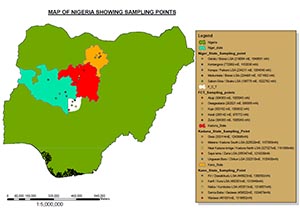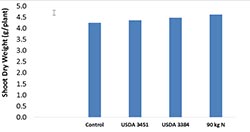Cowpea (Vigna unguiculata) is a major staple in Nigeria. Despite this, its yield has remained low at 450 kg ha-1 (Omotosho, 2014). Soil infertility, particularly low levels of nitrogen (N), phosphorus and potassium, has been identified as one of the constraints to bridging the yield gap that exists in cowpea production (Mfillige et al., 2014). Grain legumes are normally able to meet part of their nitrogen need through biological nitrogen fixation (BNF). This is however, not always the case, due to the presence of incompatible or ineffective indigenous rhizobial strains in the soil, among other reasons. This limitation can be overcome by the use of elite inoculant strains to improve the input of N from BNF. Furthermore, there is paucity of information on response of cowpea to inoculation in soils of the Nigeria savannas, which account for the major cowpea production in the country. In view of this, a need-to-inoculate experiment was conducted at the greenhouse of the Federal University of Technology, Minna, between October and November 2015 with the following objectives:
- to ascertain if cowpea growth in savanna soils is limited by N;
- to establish if the N-limitation can be overcome by the use of rhizobial inoculant strains.
|
The experiment was a factorial combination of N-sources (Control – devoid of added N or inoculant, inoculant strains and 90 kg N ha-1), two varieties of cowpea and soils collected from 20 locations in Nigeria savanna as shown in Figure 1. Inoculant strains USDA 3451 and 3384 are of broad spectrum particularly for use in cowpea and groundnut (N2Africa, 2011). All the pots were treated with basal application of essential nutrient element except N, which was applied to only the N-treatments. The experiment was managed in a completely randomized design using three replicates. Plants were harvested seven weeks after planting. Plant shoot dry weight (SDW) were compared as indices of N need of the plants. It is established that N stimulates shoot growth of crop (Moawad and Shamseldin, 2010). |
Figure 1. Map of locations in Nigeria Savannas where soil samples were collected |
|
The results showed that the main effects of N-source, variety and location were significant, but not their interactions. The SDW of plants that received 90 kg N ha-1 was significantly (P<005) greater than that of the control group, indicating that BNF by the indigenous rhizobia only partially met the N need of the crop (Figure 2). The inoculant strains increased the SDW of both cowpea varieties over the control plants in 16 out of the 20 locations. The increase however, varied among locations with a range of 3%-70% for USDA 3384 and 3% - 49% for USDA 3451. An increase of at least 15%, which represent an economic threshold (Singleton et al., 1990), was obtained in 10 locations for each of the two inoculant strains. Cowpea variety IT99k-573-1-1 had a marginally better response to inoculation than variety IT93K-452-1. |
I-LSD (P<0.05) Figure 2. Effect of rhizobial inoculation on shoot dry weight of cowpea |
These results suggests that the two elite inoculant strains could establish effective symbiosis with cowpea in soils of the Nigeria savanna. Thus enhancing the yield of cowpea. However, given that the SDW of the inoculated plants were still marginally lower than those of the N-treated plants, a greater number of cowpea inoculants need to be evaluated for cowpea in the Nigeria savanna, which could serve as a cheaper alternative to inorganic N-fertilizer application. In 2016, more inoculant strains will be evaluated for their effectiveness on cowpea in a field experiment.
Adediran Olaotan A., Federal University of Technology, Minna, Nigeria.
References:
Bala, A. (2011). Collection and maintenance of elite rhizobial strains, retrieved from www.N2Africa.org. pp. 6.
Mfillinge, A., Kevin, M. & Ndakidemi, P. A. (2014). Effects of Rhizobium inoculation and supplementation with P and K, on growth, leaf chlorophyll content and nitrogen fixation of bush bean varieties. American Journal of Research Communication, 2(10) pp. 49-87.
Moawad, H. and Shamseldin, A. (2010). Inhibition of nitrogenase enzyme and complete suppression of nodulation in common bean (Phaseolus vulgaris) at high levels of available Nitrogen. Journal of Agriculture and Environmental Science, 7(1) pp. 5-79.
Omotoso, S. O. (2014). Influence of NPK 15-15-15 fertilizer and pig manure on nutrient dynamics and production of cowpea, Vigna Unguiculata L. Walp. American Journal of Agriculture and Forestry, 2(6) pp. 267-273.
Singleton, P. W., Somasegaran, P., Nakao P., Keyser, H. H., Hoben H. J. and Fergason, P. I. (1990). Applied BNF Technology: a practical guide for extension specialist. NifTal, USA, pp. 282.


